Examination 1 Linear and Metric
What follows is the draft of examination 1 which had been prepared before
Gustav. Some questions are not
complete, and the final two questions (14 & 15) had not yet been prepared, but
it can serve as a useful self-diagnostic
of your math skills .
You should "take the test" in as realistic a fashion as possible. That is,
set a 50 minute time limit, and devote
that time solely to working these problems.
This document has two copies - one with correct answers marked and one without...
1. scientific notation - metric prefixes The "dry land" regions of planet
Earth have a combined surface
area of about 1.49 x 1014 m2. A good estimate of the total population of the
planet is about 6.72 x 109 persons. If
the people were evenly distributed over the land area of the planet, what would
be the population density, in
units of people per square kilometer ?
a)
b)
c)
d) 45
e) none of the above are even approximately correct
2. unit conversion problem - linear Last year's winner of NASTuRR's (National
Association of
Snapping Turtle Reptile Racing) " Campbell's Cup" (can you say "turtle soup")
was an 80 kg Alligator
Snapping Turtle (Macrochelys temminckii) named Bubba VI, who was clocked in the
straightaway of the Back
Vacherie Dragway at a speed of 12 centimeters per second. Expressed in
kilometers per hour, this blistering
pace is about
a)
b) 0.43 km/hr
c)
d)
e) none of the above are even approximately correct
3. unit conversion problem - 3D A die (one half of a pair of dice) is a cube
of volume approximately 2.9
cm3. This volume is equivalent to

e) none of the above are even approximately correct
4. density and unit conversion problem Gold is 18 times as dense as water.
1000 kg of water (a so called
metric ton) can cover a square 31.6 meters on a side to a depth of 1 mm.
Approximately how large a square
could 1000 kg of gold cover, to the same depth?
a) 1.8 m on a side
b) 130 m on a side
c) 31.6 m on a side
d) 7.4 m on a side
e) none of the above are even approximately correct
5. algebra problem - ratio of polynomials solve the following equation for the value of v.

6. algebra problem - quadratic formula Find one of the approximate values of
t which satisfies the
equation below.

e) none of the above are even approximately correct
7. algebra problem - simultaneous solution with quadratic The two equations
below represent, as you will
learn in a couple of weeks, the motion of two objects, where t represents time,
and the x stands for position of
each of the objects at a given moment in time.

a)
b)
c)
d)
e) none of the above are even approximately correct
If we impose the further condition that at some time, t > 0, both x1 and x2
have the same value (that is, the two
objects are in the same place), solve this system of two equations for either x1
or x2
a) 920
b) 430
c) 390
d) 260
e) none of the above are even approximately correct
8. algebra problem - slope of graph In the
graph of x versus t shown below, the slope of the
graph is approximately
a) -1.0
b) 0.71
c) -5.0
d) -0.40
e) none of the above are even approximately correct
9. trig identity - Find the angle, θ, in degrees,
that satisfies the equation below

a) θ =
b) θ =
c) θ = 20º
d) θ =
e) no solution exists
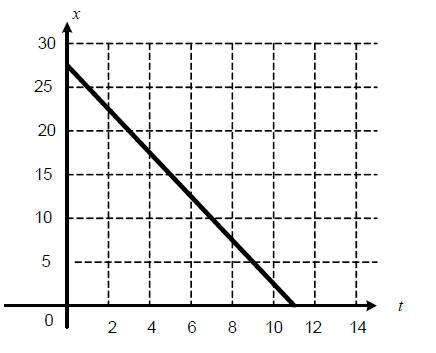
10. right triangle trig - find a side What is the approximate length of side
s of the right triangle drawn
below?
a) 23 cm
b) 17 cm
c) 11 cm
d) 9.4 cm
e) none of the above are even approximately correct
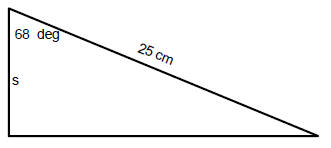
11. right triangle trig - find an angle In the right triangle drawn below ,
what is the approximate measure of the
angle adjacent to side CB ?
a) 31º
b) 59º
c) 45º
d) 23º
e) none of the above are even approximately correct
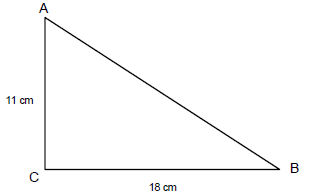
12. geometry - area A can of Campell's Turtle Soup is a
cylinder about 7.0 cm in diameter and about 10. cm tall. The
area of the paper label that wraps around the can is
approximately (neglect any overlap of the ends of the label)
a) 39 cm2
b) 220 cm2
c) 380 cm2
d) 70 cm2
e) none of the above are even approximately correct
13. geometry - volume In a recent high altitude experiment, some LSU physics
students used 1500 liters
of helium to inflate a latex sounding balloon that would ascend to an altitude
of over 30 km. What was the
approximate diameter of the (assumed spherical) balloon just after inflation?
a) 1.7 m
b) 3.1 m
c) 5.4 m
d) 9.2 m
e) none of the above are even approximately correct
14. ???????????
15. ???????????
1. scientific notation - metric prefixes The "dry land"
regions of planet Earth have a combined surface
area of about 1.49 x 1014 m2. A good estimate of the total
population of the planet is about 6.72 x 109 persons. If
the people were evenly distributed over the land area of the planet, what would
be the population density, in
units of people per square kilometer?
a)
b)
c)
* d) 45
e) none of the above are even approximately correct
2. unit conversion problem - linear Last year's winner of
NASTuRR's (National Association of
Snapping Turtle Reptile Racing) " Campbell's Cup" (can you say "turtle soup")
was an 80 kg Alligator
Snapping Turtle (Macrochelys temminckii) named Bubba VI, who was clocked in the
straightaway of the Back
Vacherie Dragway at a speed of 12 centimeters per second. Expressed in
kilometers per hour, this blistering
pace is about
a)
* b) 0.43 km/hr
c)
d)
e) none of the above are even approximately correct
3. unit conversion problem - 3D A die (one half of a pair
of dice) is a cube of volume approximately 2.9
cm3. This volume is equivalent to
* a) 2.9 x 1021 nm3
b) 2.9 x 10-2 m3
c) 2.9 x 10-5 km3
d) 2.9 x 106 mm3
e) none of the above are even approximately correct
4. density and unit conversion problem Gold is 18 times as
dense as water. 1000 kg of water (a so called
metric ton) can cover a square 31.6 meters on a side to a depth of 1 mm.
Approximately how large a square
could 1000 kg of gold cover, to the same depth?
a) 1.8 m on a side
b) 130 m on a side
c) 31.6 m on a side
* d) 7.4 m on a side
e) none of the above are even approximately correct
5. algebra problem - ratio of polynomials solve the following equation for the value of v.

e) no solution exists
6. algebra problem - quadratic formula Find one of the
approximate values of t which satisfies the
equation below.

e) none of the above are even approximately correct
7. algebra problem - simultaneous solution with quadratic
The two equations below represent, as you will
learn in a couple of weeks, the motion of two objects, where t represents time,
and the x stands for position of
each of the objects at a given moment in time.

a)
b)
c)
d)
e) none of the above are even approximately correct
If we impose the further condition that at some time, t >
0, both x1 and x2
have the same value (that is, the two
objects are in the same place), solve this system of two equations for either x1
or x2
a) 920
b) 430
c) 390
* d) 260
e) none of the above are even approximately correct
8. algebra problem - slope of graph In the
graph of x versus t shown below, the slope of the
graph is approximately
a) -1.0
b) 0.71
c) -5.0
d) -0.40
* e) none of the above are even approximately
correct
9. trig identity - Find the angle, θ, in degrees,
that satisfies the equation below

a) θ =
b) θ =
* c) θ = 20º
d) θ =
e) no solution exists

10. right triangle trig - find a side What is the
approximate length of side s of the right triangle drawn
below?
a) 23 cm
b) 17 cm
c) 11 cm
* d) 9.4 cm
e) none of the above are even approximately correct
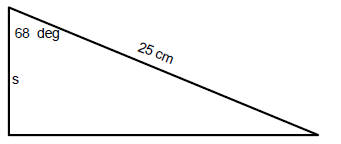
11. right triangle trig - find an angle In the right
triangle drawn below, what is the approximate measure of the
angle adjacent to side CB ?
* a) 31º
b) 59º
c) 45º
d) 23º
e) none of the above are even approximately correct
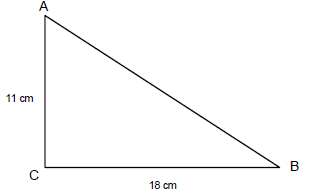
12. geometry - area A can of Campell's Turtle Soup is a
cylinder about 7.0 cm in diameter and about 10. cm tall. The
area of the paper label that wraps around the can is
approximately (neglect any overlap of the ends of the label)
a) 39 cm2
* b) 220 cm2
c) 380 cm2
d) 70 cm2
e) none of the above are even approximately correct
13. geometry - volume In a recent high altitude
experiment, some LSU physics students used 1500 liters
of helium to inflate a latex sounding balloon that would ascend to an altitude
of over 30 km. What was the
approximate diameter of the (assumed spherical) balloon just after inflation?
a) 1.7 m
* b) 3.1 m
c) 5.4 m
d) 9.2 m
e) none of the above are even approximately correct
| Prev | Next |